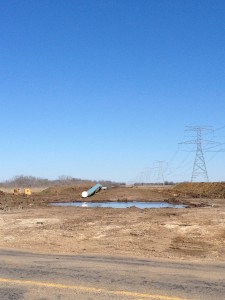The Texas Tribune recently published an article titled Pipeline Companies Paying More to Cross Private Land. Due to the number of pipeline projects going on across the state right now, as well as recent jury verdicts favorable for landowners, it is important for landowners to be aware of various compensation ideas to consider if a pipeline seeks to obtain an easement across their property. I recently published a thorough pipeline easement negotiation checklist to assist landowners in all aspects of negotiation, available here.
There are several important factors to consider when determining compensation.
Value for the actual easement area. The most well known compensation is that for the actual property being taken. Generally, a landowner is entitled to receive market value for the easement being sought (or more if he or she negotiates well). Oftentimes, pipeline companies offer payment either per foot or per linear rod (which is 16.5 feet). This compensation, however, may not be the best option for a landowner. Landowners should consider seeking payment per square foot, thus encompassing the width of the easement as well as the length and ensuring the landowner is paid for the total amount of property used by the pipeline company. Consider an owner with a 1 acre tract of land. If a pipeline company pays per foot or per rod, the landowner will receive the same amount of compensation whether the company obtains a 100 foot wide easement or a 50 foot wide easement. If payment is calculated by square foot, however, the landowner receives additional compensation where additional land is used.
Temporary work space. Frequently, pipeline companies seek a temporary work easement along with the permanent pipeline easement. These temporary easements are wider than the permanent easement, but are needed in order for the company to dig the pipeline trench and to utilize the heavy equipment necessary to lay the line. Landowners should seek payment not only for the permanent easement, but also for the temporary work easement.
Remainder damages. When only a portion of property is taken by a pipeline, this may result in decreased value for the remainder of the property that was not taken. These damages are referred to as “remainder damages” and are available to landowners under Texas law. These damages are generally calculated by comparing the market value of the property before the taking and the market value of the property after the taking, the difference being the damage award. For example, if a pipeline company seeks a 50 foot easement, but that easement will cut off access from the property to a major roadway, there could certainly be remainder damages involved. As previously discussed on this blog, a Johnson County jury rendered a verdict in a pipeline easement case earlier this year increasing the amount due to the landowner from the $80,000 offered by the pipeline company to $1.6 million due to the remainder damages.
Negotiation costs. Landowners may also want to consider requesting the pipeline company pay for the costs incurred by the landowner during the negotiation cost, such as attorney’s fees, appraiser costs, or survey costs.
Categorization of damages. Landowners should speak with an accountant to determine how payments should be structured and defined and the tax consequences that may flow therefrom. For example, a payment categorized as payment for the purchase of an easement may be treated differently for tax purposes than a payment categorized as remainder damages. It may be in the landowners’ best interest to request the company categorize payments in certain ways based upon the advice of a tax professional.












